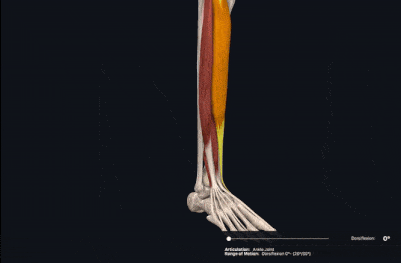
Tired of Stretching Your Calf Muscles? Try These Alternatives to Improve Your Ankle Mobility
Original research
vonGaza, G. L., & Chiu, L. Z. F. (2021). Comparison of alternative methods to improve weight-bearing sagittal plane anterior leg rotation. Journal of Strength and Conditioning Research, Publish Ahead of Print, 1–7. https://doi.org/10.1519/jsc.0000000000004150
Background
This study focused on two different ways to improve anterior leg rotation which you may know as ankle mobility (dorsiflexion). This action is the result of the shin bone (tibia) moving forward relative to the stationary foot on the ground.

Ankle dorsiflexion in action (Image courtesy of Complete Anatomy)
Many sports involve jumping, running and landing in some capacity. Critically, the ankle plantar flexor muscles (calves) and knee extensor muscles (quadriceps) are heavily involved in producing and absorbing forces generated during these movements.
Sufficient anterior leg rotation is important for these muscles to do their jobs well. When anterior leg rotation is restricted energy absorption through the muscles is reduced, and forces are transferred to other soft tissues like ligaments and bone. This can lead to a higher risk of injuries like patellar tendinopathy (Jumper’s knee) or more significantly, anterior cruciate ligament (ACL) rupture.
Studies have shown that anterior leg rotation is also dependent on movement at the foot. When weight is loaded onto the foot while on the ground, such as in a lunge, squat or even during a walking stride, the rearfoot (that spans from the heel to the midfoot) will shift forward, or plantarflex. This movement allows the leg to rotate further forward resulting in more anterior leg rotation.
Previous research by Dr. Chiu’s program has led to the theory that rearfoot plantar flexion is influenced by how well the muscles under your foot (i.e. the plantar intrinsic muscles/plantar aponeurosis) can be lengthened, as well as the force produced by the calf muscles that attach to the heel.
The goal of this study was to look at two different ways to increase rearfoot plantar flexion to improve overall ankle mobility.
What Was Done
The study used two interventions:
1. Self-massage of the plantar intrinsic muscles and plantar aponeurosis by rolling a golf ball under the foot, and self-stretching with hands, pulling the toes into extension and the foot into dorsiflexion, to stretch the plantar intrinsic muscles and plantar aponeurosis. This causes the plantar intrinsic muscles and plantar aponeurosis to be more extensible and allow for more rearfoot PF.
2. Strengthening of the calcaneal muscles by performing the glute-ham-gastroc raise exercise. This will strengthen the calf muscles, and should allow for greater rearfoot PF. This method was combined with the self-massage and stretching of the intrinsic plantar muscles.
To measure the effectiveness of these interventions, the study used two tests: 1. a knee to wall lunge test and 2. a partial squat test, where markers were attached to subjects to study their movement in 3D.
What Was Found
Both interventions, stretching and stretching combined with strengthening of the calves led to an improvement in anterior leg rotation during the knee to wall lunge test. Strengthening the calves did not seem to add significant additional benefits to the stretching. However, there have been previous studies that suggest that solely strengthening the calves can lead to increases in ankle range of motion.
Neither intervention caused noticeable increases in anterior leg rotation in the partial squat test. This could be due to the more complex technique demands of the squat compared to the relatively simple lunge, as suggested by the authors. When you go down in the squat your center of gravity shifts forward. This can cause increased muscle activation in the plantar intrinsic muscles, which restricts rearfoot PF and in turn, restricts anterior leg rotation. In the lunge, your center of gravity is maintained easily because your body weight doesn’t shift forward or backward as much.
What Does This Mean For You? Key Takeaways
The first solution that most people will look to when trying to improve their ankle mobility is to stretch and lengthen the ankle plantar flexors. This is typically done through static stretching, foam rolling or releasing the gastrocnemius, fibularis longus and tibialis posterior muscles.
If you are someone who wants to reduce your potential risk of knee injury, gain extra lower body strength benefits from deeper lunge and squat movements, or improve force production and absorption in running and jumping, it’s worth considering other methods to improve anterior leg rotation as outlined by this study:
Start with rolling out and self-massaging the plantar muscles for a total of 4 minutes before your workout and try incorporating 3 sets of 5-10 reps of the glute-ham-gastroc raise into your exercise program. These could lead to that extra ankle range of motion that you need!

